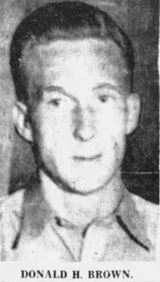Beaten, shot and set on fire
When hunting for a skip, be careful what you ask for, as a repossessor learned the hard way on New Year’s Eve in 1952 Dallas. Soon after waking up in the new year, the state was in shock by what at the time was reported as the most violent and heinous murders in the city’s illustrious history. As malicious and macabre was the murder, the tragedy that struck in its aftermath was equally disheartening. Unusual for its time, the murder and trial were reported on television news, which we have clips of.
Blood and Fire on New Years Eve
Temperatures had dropped near freezing on New Year’s Eve as the taxi driver spotted the burning car parked on an east Dallas side Street. Flames glowed through the charred windows illuminating the dark street sending the cab driver to call the police, unaware of the car’s macabre contents. Arriving fire and police soon stumbled across the most heinous repossession murder in the industries history and at the time, one of the worst in the history of Dallas.
Having extinguished the fire in the car, it became immediately apparent to the firefighters that there was something laid out on the floorboards of the sedan. Upon closer examination, they discovered it was a someone, but with no identification on the body, they could only assume who it was based on the vehicle registration.

Twenty-five-year-old Edwin Joe Campbell had been working as a collector and skip tracer for the Pacific Finance Company for three years that night. He had developed into a skilled skip tracer and was in the process of closing in on a debtor who’d skipped out three months behind on loan payments for a 1947 Buick Sedan. Unfortunately, he found him.
Investigating officers pulled Campbells burnt body from the charred wreckage to find four .25 caliber bullet holes in the back of his head. Coincidentally, the cab driver carried a pistol of the same caliber and was arrested as a suspect, but soon released. The Coroner later discovered that Campbell had also suffered a broken jaw and had

several teeth knocked out showing evidence of a severe beating. Digging in deeper to Campbell’s activities of the early evening, they soon discovered that Campbell had been hot on the trail of unemployed bus driver and debtor, twenty-four-year-old Donald Hawkins Brown.

Police soon discovered that Brown had recently been living in boarding house with his wife and two small children three blocks away from where the burning car was found. Arriving at the flat, they found Brown’s room vacant and empty, except in the attic where they discovered a pair of mens pants covered in blood and smelling of gasoline. Also found, was Campbell’s wallet and some personal belongings.
A nationwide manhunt ensued with much of the nation on the lookout for the 47’ Buick Sedan, Texas license plate JVT801. But Brown hadn’t gone far and had assumed the alias surname “Gross” the day after the crime. Investigators moved on a tip that Brown had recently applied for a job at a taxidermy shop in Fort Worth and swooped in on him when he came to discuss the job with the shop owner on January the 14th.
Once in custody, Brown denied having killed Campbell, but did admit to knowing who he was. Asked where he was that evening, Brown just lowered his head, wrung his cuffed hands and replied “No, I don’t.” Also arrested as an accomplice was Brown’s wife, Billie Joe, who furiously denied any knowledge of the crime and claimed to have no idea why her husband, she and her two children, eight-months and two-years-old were taken into police headquarters.
Campbell, a Texas Tech graduate and son of a Texas Ford dealer, was laid to rest on January 3, 1953, at St. Rita’s Catholic Church. Campbell left behind a widow, Helen and an infant son.
Justice was swift once upon a time, and by April 20, 1953, the trial against Brown commenced. Although the murder weapon was not located, during the trial, the District Attorney presented four key pieces of evidence. Brown’s bloody trousers, Campbell’s personal items found in the attic of Brown’s rented flat, testimony from his landlady that he, his wife and children had moved in the middle of the night the night of the crime and witness testimony by neighbors who had seen Campbell and Brown meet at the boarding house and in an argument over the past due payments and that Campbell had threatened to repossess the car then.
On the defense, Brown’s wife, Billie Joe, testified that he had been home all night long. Explaining the blood on his trousers, she testified that he’d broke a tooth and cut his lip changing a tire that night. Mrs.’s Brown’s perjury was quickly dismissed as the DA had already tested the blood on the trousers and some found in the driveway which were determined to be O positive, the same as Campbell. Brown, nor his attorney had an answer for Brown’s blood type.

It took six days to pool the jury and about three days of trial, but on April 29, 1953, after less than two hours of jury deliberation, the jury had reached a decision. Before a packed courthouse and, unusual for the era, filmed for television, the verdict was read. Campbell was sentenced to death.
Brown, appeared unphased and simply stated “All right.” Brown’s wife and mother broke into tears and clung to him until ultimately, he was dragged away into custody from the courtroom.
Also present at the trial was Campbell’s twenty-three-year-old widow, Helen. On May 7th, while visiting her sister and brother-in-law in Odessa where she was looking for work, she was sharing a soda with them, when she went to the bathroom. Soon after, Helen was discovered dead by suicide on the bathroom floor. She was buried in Ranger, Texas alongside Joe Campbell. They left behind a two-year-old orphan son, Stephen Allan Campbell.
Brown professed his innocence and managed to receive reprieve after reprieve until justice had run out of patience with him. On his last night on death row, Brown refused his final meal and told a reporter that; “It’s their show, I hope they enjoy it.” Brown was executed in the electric chair at midnight on January 12, 1955. He never confessed.
In an industry with many murders, and some unsolved, this one goes down as probably the most violent, gruesome, and callous.
The above story is just one of many from my book “Repo Blood” A Century of Auto Repossession History available by Archway Publishing and available online at Amazon, Barnes and Noble, Walmart and most online book sellers.
This book will make excellent Christmas presents for staff and clients alike.
Buy a copy today!
All images and video courtesy of University of North Texas Libraries, The Portal to Texas History, https://texashistory.unt.edu; crediting UNT Libraries Special Collections.












Facebook Comments